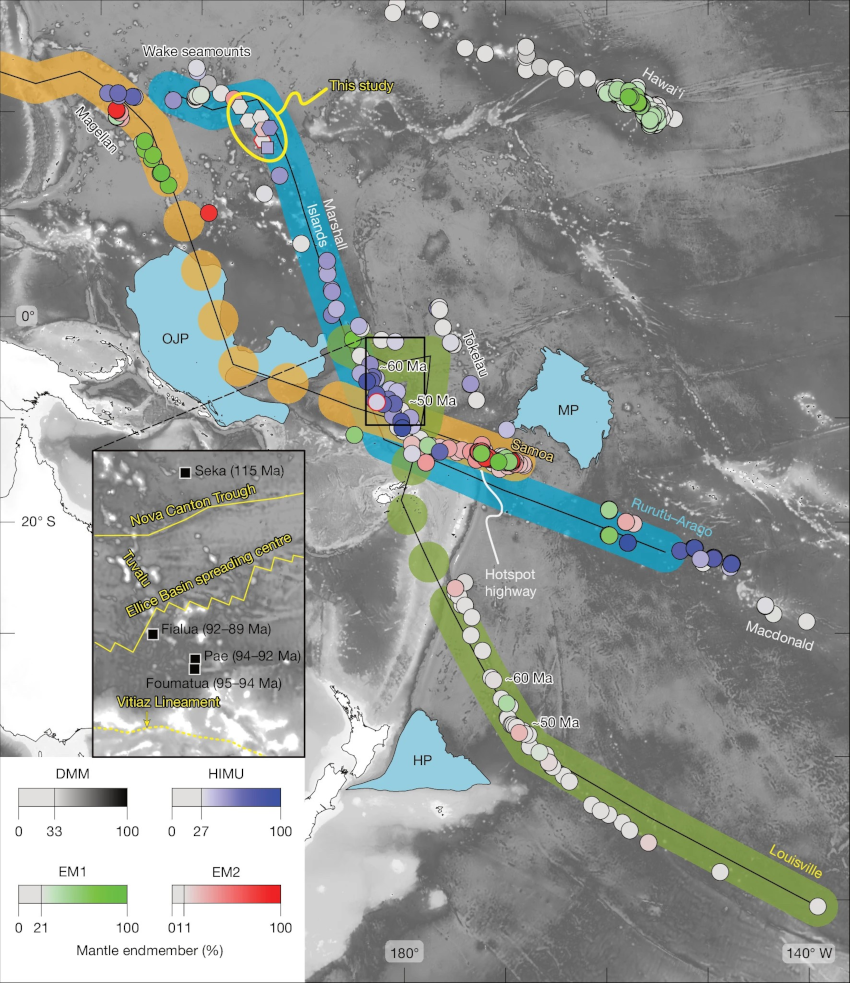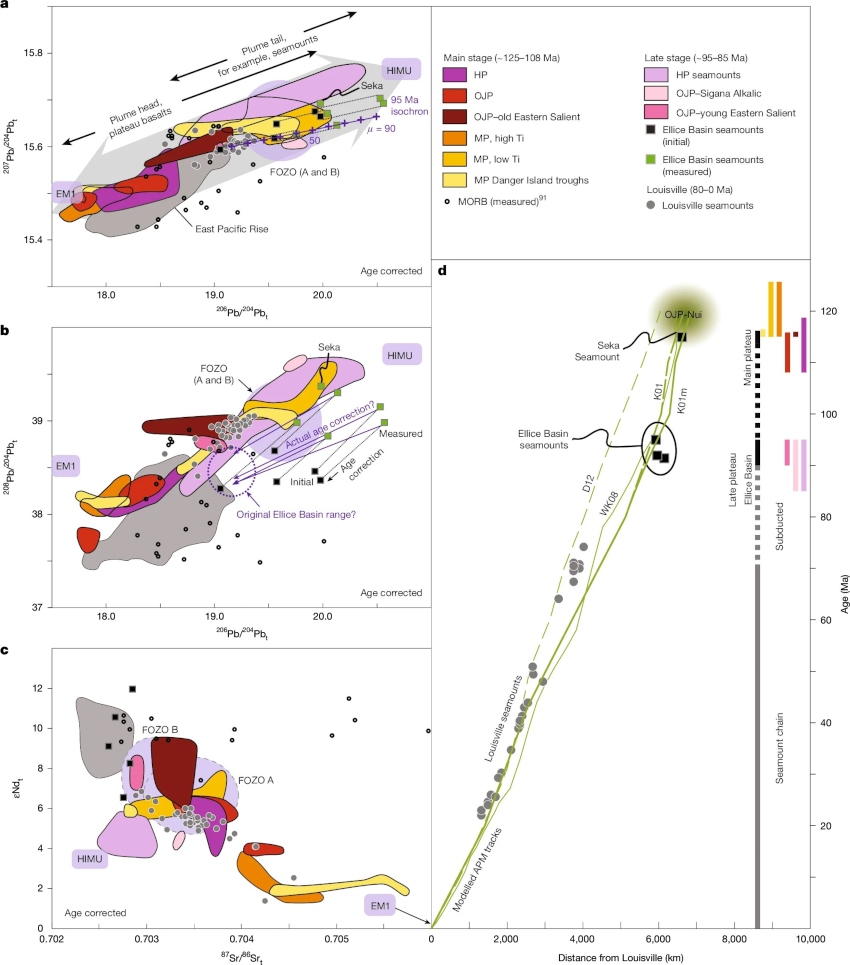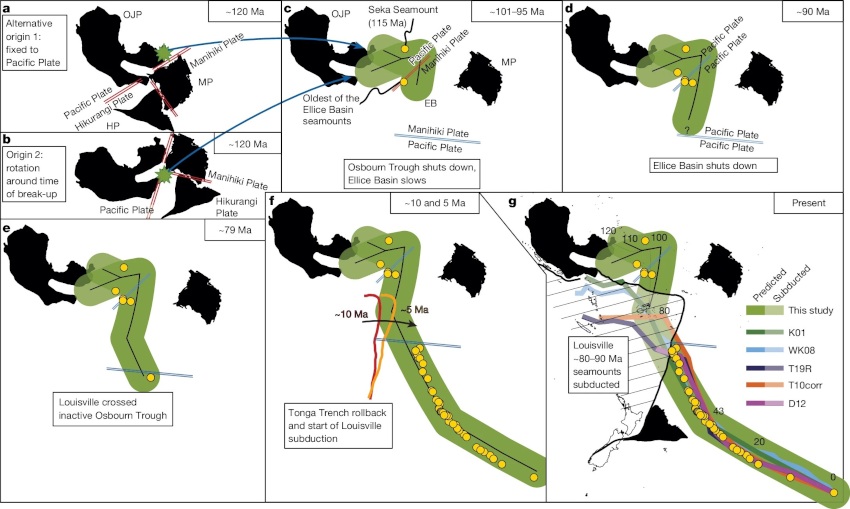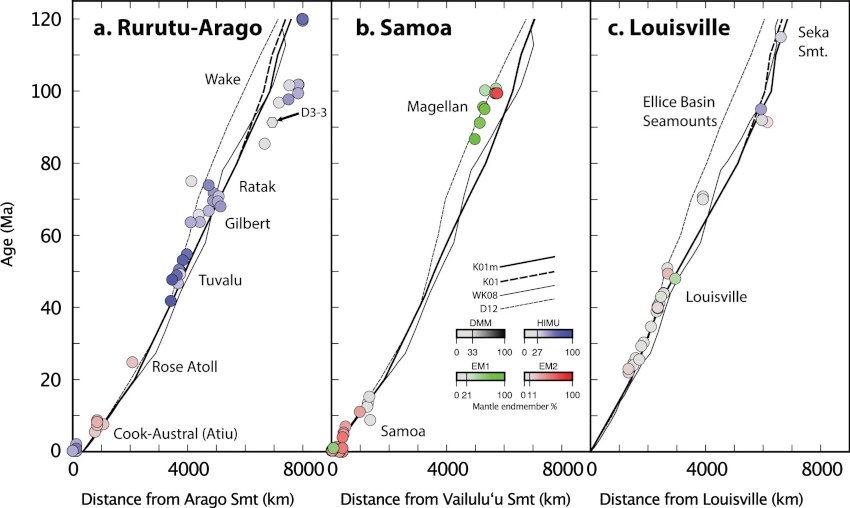2025 June LIP of the Month
Pacific hotspots reveal a Louisville-Ontong-Java Nui tectonic link
Konter, J. G., Finlayson, V. A. (vfinlays@umd.edu), Konrad, K., Jackson, M. G., Koppers, A. A. P., Wessel, P., Beethe, S., Bizimis, M., Alverson, A., Kelley, C.
Extracted and modified from:
Konter, J. G., Finlayson, V. A., Konrad, K., Jackson, M. G., Koppers, A. A. P., Wessel, P., et al. (2025). Pacific hotspots reveal a Louisville-Ontong-Java Nui tectonic link. Nature. Retrieved from https://eartharxiv.org/repository/view/5573/
-
Introduction
Volcanic hotspots are thought to form by melting in an upwelling mantle plume head followed by melting of the plume tail. Plate motion then generates an age-progressive volcanic track originating from a large igneous province (LIP) to a presently-active hotspot.
The most voluminous LIP on Earth is the ~120 Ma Ontong Java Plateau (OJP) in the mid-Pacific (Figure 1). However, the OJP lacks an obvious connection to a younger hotspot track. Although the Louisville hotspot track was originally proposed as a candidate, limited constraints for Pacific absolute plate and plume motion prior to 80 Ma suggest a mismatch (Chandler et al., 2013). Furthermore, the genetic relationships between the isotopic compositions of LIPs and hotspot tracks are often difficult to constrain due to temporal variations in mantle source contributions, even when a geographic relationship is clearly established between the two (Hoernle et al., 2015).

Figure 1 (from Konter et al., 2025). Map of Pacific hotspot tracks and color-coded geochemical lava flow compositions. Sample data (see Konter et al., 2025 for sources and details) for Pacific hotspot tracks demonstrate unique signatures for Rurutu-Arago (blue-to-grey circles; see Methods for details on color coding) and Samoa (red and green) and thus allow for the effective geochemical tracing of these hotspots, when combined with seamount ages. New Wake Island region samples linked to Rurutu-Arago are shown as hexagons; a Wake sample unrelated to Rurutu-Arago is shown with a square symbol. Ellice Basin Group and the New Wake samples with a red outline are confirmed phosphatized (See Alteration section in Methods in Konter et al. 2025) and not considered in discussions of 143Nd/144Nd behavior. The colored tracks show predicted hotspot tracks following the new K01m absolute plate motion (APM) model (specifically, 80-100 Ma stage represented by the Wake-Marshall and Magellan areas), modified from the original K01 model from Koppers et al. (2001). The dashed portions of the predicted Louisville hotspot track mark where the track was subducted. For Louisville (green), the updated APM predicts an origin at Ontong Java Plateau (OJP). The new APM modeling relies on Wake-Marshall and Magellan seamounts, omitting the Shatsky and Mid-Pac groups, and for the first time directly relates the Louisville hotspot to OJP. Hawaiian-Emperor hotspot sample data are shown for reference. See the Supplementary Information for data sources. Inset) Locations and ages of all Ellice Basin Seamounts and Seka Seamount, as confirmed by geochronology, as black squares. The Tuvalu chain, Nova Canton Trough, Ellice Basin Spreading Center, and Vitiaz Lineament are shown in yellow.
-
Formation of the OJP
The OJP is a fragment of a far larger “superplateau” emplaced largely around ~116 Ma (Davidson, Koppers, Sano, et al., 2023) that rapidly fragmented into the Ontong-Java, Manihiki, and Hikurangi plateaux (Chandler et al., 2012, 2013; Taylor, 2006), referred to herein as Ontong Java-Nui (OJP-Nui). Shortly after, or near-contemporaneously with the formation of the three plateaus, the short-lived (~120-95 Ma) Ellice Basin opened (Benyshek et al., 2019; Davidson, Koppers, & Konter, 2023; Konter et al., 2025; Taylor, 2006), splitting the OJP-Nui superplateau apart (Figure 1).
In addition to the kinematic evidence, some geochemical evidence supports the superplateau (and fragmentation) hypothesis. (Timm et al., 2011) found evidence of geochemically similar lavas erupted around the same time from both the Manihiki and Ontong Java plateaux, suggesting a genetic relationship exists between the two platforms (Figure 2). The Hikurangi Plateau also hosts lavas both co-eval with and isotopically similar to lavas produced at both OJP and the Manihiki Plateau (e.g., Figure 2; Hoernle et al., 2010).
Several origins have been proposed for the OJP. While the mantle plume origin hypothesis is most commonly accepted for the origin of the OJP and other LIPs (e.g., Campbell, 2005; Mahoney et al., 1993), the lack of any clear geochemical or tectonic links to a hotspot track invited alternative hypotheses. One such alternative suggested a bolide impact (Ingle & Coffin, 2004) as a possible origin for the OJP and several nearby, co-eval, geochemically similar basins argued to be potential crater remnants in the Western Pacific.
-
Challenges linking the OJP and Louisville
The ~79-0 Ma Louisville hotspot track is unusually isotopically homogeneous compared to most other hotspot tracks so far documented. The Louisville track samples an almost exclusively FOZO-like (FOcal or FOcus ZOne; Hart et al., 1992) mantle source (Beier et al., 2011; Vanderkluysen et al., 2014). By comparison, the OJP-Nui superplateau is far more heterogeneous, sampling a range of depleted (Depleted MORB Mantle or DMM-like) to enriched (Enriched Mantle 1 or EM1-like) and even some HIMU-like (high time-integrated μ, where μ=238U/204Pb) compositions at various stages of its emplacement (Figure 2; Hoernle et al., 2010; Mahoney et al., 1993; Mahoney & Spencer, 1991; Tejada et al., 1996, 2002, 2004, 2023; Timm et al., 2011).
The contrast in diversity of sampled components has precluded efforts to establish a genetic link between the OJP and Louisville, although Vanderkluysen et al. (2014) argued in favor of commonality between the two provinces (Figure 2). Additional sampling later revealed the presence of FOZO-like samples along the Eastern Salient of the OJP that closely resemble compositions found along the Louisville track, strengthening the case for a genetic link between hotspot and LIP (Tejada et al., 2023).

Figure 2 (from Konter et al., 2025). Geochemistry and geochronology of volcanic structures linked to the OJP-Nui and Louisville system. a Age-corrected 207Pb/204Pb vs. 206Pb/204Pb isotope compositions for Ontong Java Nui, and related structures. b Age-corrected 208Pb/204Pb vs. 206Pb/204Pb isotope compositions for Ontong Java Nui, and related structures. c ε143Nd vs. age-corrected 87Sr/86Sr for Ontong-Java Nui and related structures. d Age progression for the Louisville hotspot track (symbols same as in plots). Ellice Basin Seamounts and Seka Seamount are shown. Pb-isotope data for Ontong-Java (OJP), Manihiki (MP), and Hikurangi plateaus (HP), which represent the main pulses of voluminous plateau-building volcanism (~120 and ~90 Ma), are frequently less radiogenic, but extend to radiogenic values in some settings. By contrast, smaller structures such as seamounts are confined to intermediate-to-radiogenic values. Louisville and Ellice Basin seamounts exhibit more radiogenic Pb (Panel A-B) and Nd (Panel C) isotopes, with some Ellice Basin samples being particularly radiogenic due to varying degrees of seawater U influence and phosphatization, respectively. Despite alteration resulting in superficial resemblance to HIMU-like Danger Island (Panel B) or DMM-like (Panel C) compositions, the Ellice Basin Seamounts sampled a mixture of FOZO and DMM (see Supplemental Material in Konter et al., 2025) that may have originally resembled slightly depleted Louisville-type compositions. Green squares are present-day Ellice Basin compositions, compared to corresponding age-corrected (where possible) compositions. Louisville seamount data overlap directly with some OJP basalts in Pb-Nd-Sr isotope space, and are well within the array of compositions found in the greater combined set of plateaus and structures from OJP, MP and HP. Furthermore, Ellice Basin and Seka seamounts are spatiotemporally linked to the OJP. See Methods (in Konter et al. 2025) for description of isotopic data compared to variations in plume head and plume tail stages of volcanic activity and analysis of Pb-Sr-Nd isotopic systematics in the Ellice Basin Samples.
-
New constraints on old models
Absolute plate motion (APM) of a tectonic plate can be constrained using hotspot tracks, on the assumption that mantle plumes thought to underlie many hotspots remain mostly fixed in the mantle (Morgan, 1972). Existing Pacific models rely on age-distance data from the continuous Hawaiʻi-Emperor and Louisville tracks, but their tracks older than ~80 Ma are subducted. Elsewhere on the Pacific plate, only discontinuous seamount tracks formed prior to 80 Ma (Doubrovine et al., 2012; Duncan & Clague, 1985; Koppers et al., 2021; Koppers & Sager, 2014; Tarduno et al., 2009; Wessel & Kroenke, 2009) are documented. Currently, models require ~1,200 km of latitudinal motion to link the Louisville plume to the OJP-Nui (Chandler et al., 2013; Figure 3; see Panel G), yet paleolatitude estimates from ~70 Ma to today remain within error of its present location (Konrad et al., 2018; Koppers et al., 2007) suggesting that any significant Louisville plume motion occurred earlier.

Figure 3. Cartoon of Louisville hotspot evolution. a, b, The revised model predicts that the Louisville hotspot (green swath) initiated within the OJP; however, the exact initial location is sensitive to whether the plateaus rotated around the time of OJP-Nui break-up, so two alternatives are shown for approximately 120 Ma: origin 1 (a) and origin 2 (b). c, By approximately 95 Ma, the Ellice Basin (EB) had (mostly) opened between the OJP and the MP, as suggested by the age of the oldest Ellice Basin seamounts (95.0 Ma) —located centrally in the basin—which we link to the Louisville hotspot. Seka Seamount (115.0 Ma), located at the north end of the basin, is isotopically similar to the Ellice Basin seamounts (suggesting that significant Ellice Basin spreading occurred by 115 Ma) and is also linked to the Louisville hotspot. d, Our model predicts Louisville to be present in the Ellice Basin at this time, progressing to younger ages to the south by 90 Ma. e, The oldest Louisville seamount that erupted at about 79 Ma, located south of the Osbourn Trough, represents the oldest part of the continuously defined Louisville hotspot track. f,g, In the past 5 Ma to 10 Ma (f), roll-back of the Tonga Trench caused the subductionof any Louisville seamounts with ages between 79 Ma and 90 Ma, leaving only the older (>90 Ma) Louisville hotspot-related structures in the Ellice Basin and OJP areas preserved to the present day (g). Consequently, the relationship between >79-Ma Louisville hotspot volcanism and the palaeoridge represented by the Osbourn Trough is unclear. Predicted hotspot tracksshow that only our model tracks the Louisville hotspot back to the OJP-Nui, specifically the OJP. See Konter et al. (2025) for details on this model.
-
An OJP-Louisville tectonic link
Konter et al. (2025) proposed a revision to the Cretaceous portion of Pacific APM models, where the fewest geochronological constraints are available from hotspot tracks, particularly hotspots known to have produced long-lived tracks (Figure 1). Through a combination of geochemistry and geochronology (Finlayson et al., 2018; Jackson et al., 2010, 2014; Konrad et al., 2018; Konter & Jackson, 2012; Koppers et al., 2012), we demonstrate that Samoa and Rurutu-Arago are the longest-lived Pacific hotspots, traceable to >120 Ma before subducting into the Mariana Trench. Konter et al. (2025) demonstrate that the EM2-to-EM1 Cretaceous Magellan Seamounts in the Western Pacific are age-progressive with present-day Samoan volcanism (Figure 4). New data from seamounts sampled during EX1606 (R/V Okeanos Explorer) from the Wake Island region are FOZO-like to weakly HIMU-like. Although these lavas proved difficult to obtain 40Ar/39Ar geochronology from, one lava yielded a robust 91.3 Ma age, linking it to the HIMU-to-FOZO Rurutu-Arago hotspot, currently active in the Cook-Austral region of the South Pacific (Figures 1, 4).
Using these suites of co-eval seamounts from the Magellan and Wake regions, (Konter et al., 2025) were able to recalculate the 100-80 Ma stage pole of the (Koppers et al., 2001) APM model, which notably suggests an increase in the angular velocity of the stage pole. Originally calculated by Koppers et al. (2001) to be 0.425 degrees/Myr, the modified 100-80 Ma stage pole by Konter et al. (2025) calculates an angular velocity of 0.975 degrees/Myr, which significantly increases the length of the Cretaceous portions of Pacific hotspot track reconstructions.
These newly-defined portions of the Rurutu-Arago and Samoan tracks better constrain plate rotation between 80-100 Ma, allowing us to update Pacific absolute plate motion models, and independently link the Louisville volcanic track to OJP-Nui without requiring major plume motion. The longer segment produced by the modified APM model accounts for the ~1200 km offset between OJP-Nui and the Louisville hotspot in APM modeling, placing the Louisville hotspot near the hypothesized triple junction of the OJP-Nui, near the present-day Eastern Salient of the OJP (Figure 3). Also critical is the identification of several seamounts in the Ellice Basin, east of the OJP Eastern Salient, that were volcanically active between ~115-90 Ma, much older than the dominant ~70-42 Ma volcanism in the region that has been linked to the Rurutu-Arago hotspot (Finlayson et al., 2018; Konter et al., 2008; Figure 4) and which formed shortly after the generation of the oceanic crust upon which they sit (Benyshek et al., 2019; Konter et al., 2025). These lavas are moderately isotopically depleted and heavily altered, with mantle sources originally resembling what was most likely a mixture of FOZO and DMM (Konter et al., 2025). When comparing the ages and locations of these unusually old Ellice Basin seamounts to revised APM model reconstructions, they are demonstrably age-progressive with the Louisville hotspot track and the OJP. Despite the strong alteration signature evident in the lavas, the depleted isotopic signature present in the lavas may be consistent with a geochemical transition from the more diverse (including DMM-like) mantle compositions of the OJP into the homogeneous Louisville mantle source. These seamounts may thus comprise a previously unrecognized early expression of the Louisville hotspot track emerging shortly after the breakup of OJP-Nui.

Figure 4. Age-distance relationships of the Rurutu-Arago, Samoan, and Louisville plumes. a Rurutu-Arago hotspot track. b Samoa hotspot track. c Louisville hotspot track. See Konter et al. (2025) for data sources. Data shown here are only samples with age determinations or published age estimates (where well constrained by nearby volcanoes and Sr-Pb-Nd data to permit color coding. APM models are also included for reference (WK08 = Wessel & Kroenke, 2008; D12 = Doubrovine et al., 2012 without plume drift correction; K01 = Koppers et al., 2001; K01m = modified Koppers et al., 2001 from Konter et al., 2025).
References
Beier, C., Vanderkluysen, L., Regelous, M., Mahoney, J. J., & Garbe-Schönberg, D. (2011). Lithospheric control on geochemical composition along the Louisville Seamount Chain. Geochemistry, Geophysics, Geosystems, 12(9). https://doi.org/10.1029/2011GC003690
Benyshek, E. K., Wessel, P., & Taylor, B. (2019). Tectonic Reconstruction of the Ellice Basin. Tectonics, 38(11), 3854–3865. https://doi.org/10.1029/2019TC005650
Campbell, I. H. (2005). Large Igneous Provinces and the Mantle Plume Hypothesis. Elements, 1(5), 265–269. https://doi.org/10.2113/gselements.1.5.265
Chandler, M. T., Wessel, P., Taylor, B., Seton, M., Kim, S.-S., & Hyeong, K. (2012). Reconstructing Ontong Java Nui: Implications for Pacific absolute plate motion, hotspot drift and true polar wander. Earth and Planetary Science Letters, 331–332, 140–151. https://doi.org/10.1016/j.epsl.2012.03.017
Chandler, M. T., Wessel, P., & Sager, W. W. (2013). Analysis of Ontong Java Plateau palaeolatitudes: evidence for large-scale rotation since 123 Ma? Geophysical Journal International, 194(1), 18–29. https://doi.org/10.1093/gji/ggt075
Davidson, P. C., Koppers, A. A. P., Sano, T., & Hanyu, T. (2023). A younger and protracted emplacement of the Ontong Java Plateau. Science, 380(6650), 1185–1188. https://doi.org/10.1126/science.ade8666
Davidson, P. C., Koppers, A. A. P., & Konter, J. G. (2023). Rapid Formation of the Ellice and Osbourn Basins and Ontong Java Nui Breakup Kinematics. Geochemistry, Geophysics, Geosystems, 24(7), e2022GC010592. https://doi.org/10.1029/2022GC010592
Doubrovine, P. V., Steinberger, B., & Torsvik, T. H. (2012). Absolute plate motions in a reference frame defined by moving hot spots in the Pacific, Atlantic, and Indian oceans. Journal of Geophysical Research: Solid Earth, 117(B9). https://doi.org/10.1029/2011JB009072
Duncan, R. A., & Clague, D. A. (1985). Pacific Plate Motion Recorded by Linear Volcanic Chains. In A. E. M. Nairn, F. G. Stehli, & S. Uyeda (Eds.), The Ocean Basins and Margins: Volume 7A The Pacific Ocean (pp. 89–121). Boston, MA: Springer US. https://doi.org/10.1007/978-1-4613-2351-8_3
Finlayson, V. A., Konter, J. G., Konrad, K., Koppers, A. A. P., Jackson, M. G., & Rooney, T. O. (2018). Sr–Pb–Nd–Hf isotopes and 40Ar/39Ar ages reveal a Hawaii–Emperor-style bend in the Rurutu hotspot. Earth and Planetary Science Letters, 500, 168–179. https://doi.org/10.1016/j.epsl.2018.08.020
Hart, S. R., Hauri, E. H., Oschmann, L. A., & Whitehead, J. A. (1992). Mantle Plumes and Entrainment: Isotopic Evidence. Science, 256(5056), 517–520. https://doi.org/10.1126/science.256.5056.517
Hoernle, K., Hauff, F., van den Bogaard, P., Werner, R., Mortimer, N., Geldmacher, J., et al. (2010). Age and geochemistry of volcanic rocks from the Hikurangi and Manihiki oceanic Plateaus. Geochimica et Cosmochimica Acta, 74(24), 7196–7219. https://doi.org/10.1016/j.gca.2010.09.030
Hoernle, K., Rohde, J., Hauff, F., Garbe-Schönberg, D., Homrighausen, S., Werner, R., & Morgan, J. P. (2015). How and when plume zonation appeared during the 132 Myr evolution of the Tristan Hotspot. Nature Communications, 6(1), 7799. https://doi.org/10.1038/ncomms8799
Ingle, S., & Coffin, M. F. (2004). Impact origin for the greater Ontong Java Plateau? Earth and Planetary Science Letters, 218(1–2), 123–134. https://doi.org/10.1016/S0012-821X(03)00629-0
Jackson, M. G., Hart, S. R., Konter, J. G., Koppers, A. A. P., Staudigel, H., Kurz, M. D., et al. (2010). Samoan hot spot track on a “hot spot highway”: Implications for mantle plumes and a deep Samoan mantle source. Geochemistry, Geophysics, Geosystems, 11(12), n/a-n/a. https://doi.org/10.1029/2010GC003232
Jackson, M. G., Hart, S. R., Konter, J. G., Kurz, M. D., Blusztajn, J., & Farley, K. A. (2014). Helium and lead isotopes reveal the geochemical geometry of the Samoan plume. Nature, 514(7522), 355–358. https://doi.org/10.1038/nature13794
Konrad, K., Koppers, A. A. P., Steinberger, B., Finlayson, V. A., Konter, J. G., & Jackson, M. G. (2018). On the relative motions of long-lived Pacific mantle plumes. Nature Communications, 9(1), 854. https://doi.org/10.1038/s41467-018-03277-x
Konter, J. G., & Jackson, M. G. (2012). Large volumes of rejuvenated volcanism in Samoa: Evidence supporting a tectonic influence on late-stage volcanism. Geochemistry, Geophysics, Geosystems, 13(6), n/a-n/a. https://doi.org/10.1029/2011GC003974
Konter, J. G., Hanan, B. B., Blichert-Toft, J., Koppers, A. A. P., Plank, T., & Staudigel, H. (2008). One hundred million years of mantle geochemical history suggest the retiring of mantle plumes is premature. Earth and Planetary Science Letters, 275(3–4), 285–295. https://doi.org/10.1016/j.epsl.2008.08.023
Konter, J. G., Finlayson, V. A., Konrad, K., Jackson, M. G., Koppers, A. A. P., Wessel, P., et al. (2025). Pacific hotspots reveal a Louisville-Ontong-Java Nui tectonic link. Nature. Retrieved from https://eartharxiv.org/repository/view/5573/
Koppers, A. A. P., & Sager, W. W. (2014). Chapter 4.3 - Large-Scale and Long-Term Volcanism on Oceanic Lithosphere. In R. Stein, D. K. Blackman, F. Inagaki, & H.-C. Larsen (Eds.), Developments in Marine Geology (Vol. 7, pp. 553–597). Elsevier. https://doi.org/10.1016/B978-0-444-62617-2.00019-0
Koppers, A. A. P., Phipps Morgan, J., Morgan, J. W., & Staudigel, H. (2001). Testing the fixed hotspot hypothesis using 40Ar/39Ar age progressions along seamount trails. Earth and Planetary Science Letters, 16.
Koppers, A. A. P., Staudigel, H., Phipps Morgan, J., & Duncan, R. A. (2007). Nonlinear 40Ar/39Ar age systematics along the Gilbert Ridge and Tokelau Seamount Trail and the timing of the Hawaii-Emperor Bend. Geochemistry, Geophysics, Geosystems, 8(6), n/a-n/a. https://doi.org/10.1029/2006GC001489
Koppers, A. A. P., Yamazaki, T., Geldmacher, J., Gee, J. S., Pressling, N., Koppers, A. A. P., et al. (2012). Limited latitudinal mantle plume motion for the Louisville hotspot. Nature Geoscience, 5(12), 911–917. https://doi.org/10.1038/ngeo1638
Koppers, A. A. P., Becker, T. W., Jackson, M. G., Konrad, K., Müller, R. D., Romanowicz, B., et al. (2021). Mantle plumes and their role in Earth processes. Nature Reviews Earth & Environment, 2(6), 382–401. https://doi.org/10.1038/s43017-021-00168-6
Mahoney, J. J., & Spencer, K. J. (1991). Isotopic evidence for the origin of the Manihiki and Ontong Java oceanic plateaus. Earth and Planetary Science Letters, 104(2), 196–210. https://doi.org/10.1016/0012-821X(91)90204-U
Mahoney, J. J., Storey, M., Duncan, R. A., Spencer, K. J., & Pringle, M. (1993). Geochemistry and age of the Ontong Java Plateau. Geophysical Monograph Series, 77, 233–261. https://doi.org/10.1029/GM077p0233
Morgan, W. J. (1972). Deep Mantle Convection Plumes and Plate Motions. AAPG Bulletin, 56. https://doi.org/10.1306/819A3E50-16C5-11D7-8645000102C1865D
Tarduno, J. A., Bunge, H.-P., Sleep, N., & Hansen, U. (2009). The Bent Hawaiian-Emperor Hotspot Track: Inheriting the Mantle Wind. Science, 324(5923), 50–53. https://doi.org/10.1126/science.1161256
Taylor, B. (2006). The single largest oceanic plateau: Ontong Java–Manihiki–Hikurangi. Earth and Planetary Science Letters, 241(3–4), 372–380. https://doi.org/10.1016/j.epsl.2005.11.049
Tejada, M. L. G., Mahoney, J. J., Duncan, R. A., & Hawkins, M. P. (1996). Age and Geochemistry of Basement and Alkalic Rocks of Malaita and Santa Isabel, Solomon Islands, Southern Margin of Ontong Java Plateau. Journal of Petrology, 37(2), 361–394. https://doi.org/10.1093/petrology/37.2.361
Tejada, M. L. G., Mahoney, J. J., Neal, C. R., Duncan, R. A., & Petterson, M. G. (2002). Basement Geochemistry and Geochronology of Central Malaita, Solomon Islands, with Implications for the Origin and Evolution of the Ontong Java Plateau. Journal of Petrology, 43(3), 449–484. https://doi.org/10.1093/petrology/43.3.449
Tejada, M. L. G., Mahoney, J. J., Castillo, P. R., Ingle, S. P., Sheth, H. C., & Weis, D. (2004). Pin-pricking the elephant: evidence on the origin of the Ontong Java Plateau from Pb-Sr-Hf-Nd isotopic characteristics of ODP Leg 192 basalts. Geological Society, London, Special Publications, 229(1), 133–150. https://doi.org/10.1144/GSL.SP.2004.229.01.09
Tejada, M. L. G., Sano, T., Hanyu, T., Koppers, A. a. P., Nakanishi, M., Miyazaki, T., et al. (2023). New evidence for the Ontong Java Nui hypothesis. Scientific Reports, 13(1), 8486. https://doi.org/10.1038/s41598-023-33724-9
Timm, C., Hoernle, K., Werner, R., Hauff, F., den Bogaard, P. van, Michael, P., et al. (2011). Age and geochemistry of the oceanic Manihiki Plateau, SW Pacific: New evidence for a plume origin. Earth and Planetary Science Letters, 304(1–2), 135–146. https://doi.org/10.1016/j.epsl.2011.01.025
Vanderkluysen, L., Mahoney, J. J., Koppers, A. A. P., Beier, C., Regelous, M., Gee, J. S., & Lonsdale, P. F. (2014). Louisville Seamount Chain: Petrogenetic processes and geochemical evolution of the mantle source. Geochemistry, Geophysics, Geosystems, 15(6), 2380–2400. https://doi.org/10.1002/2014GC005288
Wessel, P., & Kroenke, L. W. (2008). Pacific absolute plate motion since 145 Ma: An assessment of the fixed hot spot hypothesis. Journal of Geophysical Research, 113(B6). https://doi.org/10.1029/2007JB005499
Wessel, P., & Kroenke, L. W. (2009). Observations of geometry and ages constrain relative motion of Hawaii and Louisville plumes. Earth and Planetary Science Letters, 284(3), 467–472. https://doi.org/10.1016/j.epsl.2009.05.012
